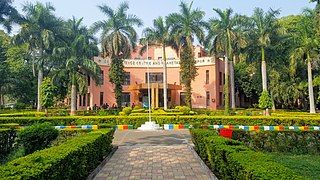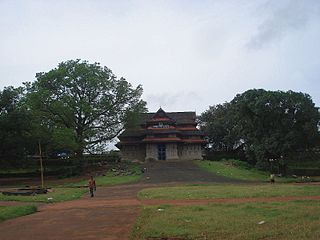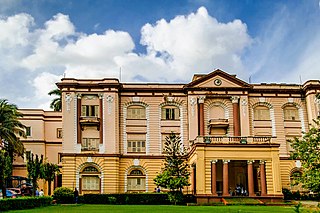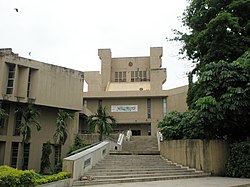
Rajivaratna Gandhi was an Indian politician who served as the 6th Prime Minister of India from 1984 to 1989. He took office after the assassination of his mother, then–prime minister Indira Gandhi, to become the youngest Indian prime minister at the age of 40. He served until his defeat at the 1989 election, and then became Leader of the Opposition, Lok Sabha, resigning in December 1990, six months before his own assassination.

The Indian National Congress (INC), colloquially the Congress Party or simply the Congress, is a political party in India with widespread roots. Founded in 1885, it was the first modern nationalist movement to emerge in the British Empire in Asia and Africa. From the late 19th century, and especially after 1920, under the leadership of Mahatma Gandhi, the Congress became the principal leader of the Indian independence movement. The Congress led India to independence from the United Kingdom, and significantly influenced other anti-colonial nationalist movements in the British Empire.

The Jawaharlal Nehru Centre for Advanced Scientific Research (JNCASR) is a multidisciplinary research institute located at Jakkur, Bangalore, India. It was established by the Department of Science and Technology of the Government of India, to mark the birth centenary of Pandit Jawaharlal Nehru, the first prime minister of independent India. It is considered one of the most prestigious research institutes in India. In 2019, JNCASR was ranked #7 among the world's top ten research institutes by Nature journal in a normalised ranking of small research institutes with high quality output.

Indira Gandhi Institute of Development Research (IGIDR) is an advanced research and educational institution in Mumbai, India. The institute's mission is to carry out research on developmental issues from a multi-disciplinary point of view. This includes economics, energy and environmental policy.

Pupul Jayakar was an Indian cultural activist and writer, best known for her work on the revival of traditional and village arts, handlooms, and handicrafts in post-independence India. According to The New York Times, she was known as "India's 'czarina of culture'", and founded arts festivals that promoted Indian arts in France, Japan, and the United States. She was a friend and biographer to both the Nehru-Gandhi family and J Krishnamurti. Jayakar had a close relationship with three prime ministers: Jawaharlal Nehru, his daughter Indira Gandhi and her son Rajiv Gandhi, and she was a close friend of Indira Gandhi. She served as cultural adviser to the latter two, confirming her preeminence in cultural matters.

Prithviraj Chavan is an Indian politician who was the 17th Chief Minister of Maharashtra, a state in Western India. Chavan is a graduate of the Birla Institute of Technology and Science, Pilani and University of California, Berkeley in mechanical engineering. He spent time working in the field of aircraft instrumentation and designing audio recorders for anti-submarine warfare in the US before returning to India and becoming an entrepreneur in 1974. Referred to in the media as a technocrat with a clean, non-controversial image, a low-profile leader. Chavan served as the Minister of State in the Prime Minister's Office in the Ministry of Parliamentary Affairs and Ministry of Personnel, Public Grievances, and Pensions. Chavan was also General Secretary of the All-India Congress Committee (AICC), in-charge of many states, including Jammu and Kashmir, Karnataka, Haryana, Gujarat, Tripura, and Arunachal Pradesh.

Rajiv Gandhi University (RGU) is the oldest university in the Indian state of Arunachal Pradesh. It is located at Rono Hills in Doimukh town, about 28km from the state capital, Itanagar. The foundation stone for the university was laid in 1984 by then-Prime Minister Indira Gandhi. The university was renamed as Rajiv Gandhi University in 2005 when UPA Chairperson Sonia Gandhi was on a visit to the state.

Rajiv Gandhi Institute of Petroleum Technology (RGIPT), in Jais, Amethi, Uttar Pradesh, India, is a training and education institute focusing on STEM and petroleum industry under IIT Kanpur. It was formally opened in July 2008.

The Raman Science Centre and Raman Planetarium Complex at Nagpur is an interactive science centre affiliated with Mumbai's Nehru Science Centre. The centre was developed to promote a scientific attitude, portray the growth of science and technology and their applications in industry and human welfare, and hold science exhibits. The centre is named after famous Nobel Prize winner Indian physicist Chandrasekhara Venkata Raman. The Raman Science Centre was inaugurated on 7 March 1992 and the planetarium was started on 5 January 1997. The centre is located opposite Gandhi Sagar Lake in the heart of Nagpur. Between 1 April 2014 and 31 March 2015 the Centre recorded a visitor count of 582,962. The centre is part of the National Council of Science Museums (NCSM), India which is also the largest network of science centres/museums under a single administrative umbrella in the world. NCSM rates the centre as regional level and it has a total floor area of 4333 sq meters.
The Indira Gandhi Planetarium, also known as the Patna Planetarium, is located in Patna's Indira Gandhi Science Complex. The planetarium was constructed through Bihar Council on Science & Technology at a total cost of about ₹110 million. It was conceptualised in 1989 by Bihar Chief Minister Shri Satyendra Narain Sinha with construction commencing in the same year, and opened for the public from 1 April 1993. It is named after senior Indian National Congress leader and former Prime Minister of India Indira Gandhi.

Nehru Centre is a centre to promote the teachings and ideals of the first Prime Minister of India, Jawaharlal Nehru, through educational and cultural programmes in the city of Mumbai, India. The Centre organises scientific, cultural and educational activities.

The National Science Centre established in 1992, is a science museum in Delhi, India. It is part of the National Council of Science Museums (NCSM), an autonomous body under India's Ministry of Culture. It stands close to Gate no 1, of Pragati Maidan overlooking the Purana Qila.

Thekkinkadu Maidanam is situated in the middle of Thrissur city of Kerala state in India. This hillock which seats the Vadakkumnathan Temple, is an open ground in the centre of the Thrissur city which is under the custody of the Cochin Devaswom Board (CDB). It hosts the spectacular cultural festival Thrissur Pooram, which is considered the Mother of all Poorams in Kerala.

National Council of Science Museums (NCSM) is an autonomous scientific organization functioning under the Ministry of Culture, Government of India for science communication through its network of science museums or science centres spread across India. It is the largest chain of science centers/museums under a single administrative umbrella in the world. There are 24 own science centers or museums and one R & D laboratory and training centre. The NCSM has been built to co-ordinate all informal science communication activities in the museum space in the country.

Birla Industrial & Technological Museum (BITM) is a science museum in Kolkata, West Bengal, India. It is a unit under National Council of Science Museums (NCSM), Ministry of Culture, Government of India. Under the governmental jurisdiction of the Council of Scientific & Industrial Research (CSIR), BITM is commonly recognized as the precursor of India's science museum concept.

Science City, Kolkata is a science centre and science park in Kolkata, West Bengal, India. It is the largest science centre in Asia containing a science museum, science park and auditoriums. It is managed by National Council of Science Museums (NCSM), Ministry of Culture, Government of India. It is located at the crossing of Eastern Metropolitan Bypass and J. B. S. Haldane Avenue in East Topsia. Saroj Ghose, the first director general of NCSM, is credited with having conceptualised this centre in 1997.

India and the Soviet Union had cooperative and friendly relations. During the Cold War (1947–1991), India did not chose sides between the Capitalist Bloc and the Communist Bloc and was a leading country of the Non-Aligned Movement (NAM). Relations ended in 1991 with the dissolution of the Soviet Union.
Rajiv Gandhi (1944–1991) was an Indian politician who served as the Prime Minister of India from 1984–89.

























